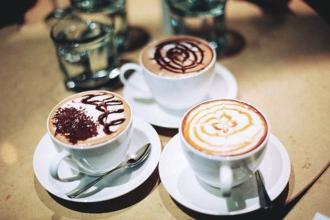Rwandan coffee with mild acidity, fine coffee beans, flavor and taste characteristics
The watershed between the Congo basin and the Nile basin runs through Rwanda from north to south, with about 80 per cent of the country draining from the Nile and about 20 per cent from the Ruzi River and Lake Tanganyika. The longest river in the country is the Niabalongo River (Nyabarongo River) in the southwest, which turns north, east and southeast into the Ruwuwu River and forms the Kagera River, which flows due north along the eastern border of Tanzania. Both the Niabarongo River and the Cagella River will eventually flow into Lake Victoria. There are many lakes in Rwanda, of which Lake Kivu is the largest. The lake is located at the bottom of the Aberdeen Rift Valley and extends along the western border of Rwanda. With a maximum depth of 480 meters, it is one of the 20 deepest lakes in the world. Several other larger lakes include Lake Burera, Lake Ruhondo, Lake Muhazi, Lake Rweru, and Lake Ihema, the largest of a series of lakes in the eastern plains of Akagera National Park, with 1/3 of the prehistoric mountain ecology in Rwanda. Naturally occurring plants have been basically confined to the country's three national parks, while terraced agriculture is dominant in other parts of the country. The Newgway Forest is the largest forest in existence, with 200 tree species, orchids and begonia. The plants in Rwanda Volcano National Park are dominated by bamboo, and most of the rest are moorlands and small areas of trees. Akagera National Park is a savanna ecosystem, with acacia up to 12.1 million (2014) of all plants, with an annual growth rate of 2.6% and a population density of 415 people per square kilometer.It is the country with the highest population density on the African continent. 83% of the population is distributed in rural areas. The official languages are Rwandan, English and French. The national language is Rwandan, and some residents speak Swahili. 56.5% of residents believe in Catholicism, 26% in Protestantism and 4.6% in Islam. The sex ratio of men and women is 93100, the average life expectancy is 64.5 years, and the proportion of people living in poverty is 37%. Since the establishment of the new regime in 1994, Rwanda has announced the implementation of a five-year transition period, the implementation of the political management model of leading, multi-party participation in politics and banning party activities. The Lu government pursued a policy of national reconciliation and unity, received and resettled returning refugees, tried the criminals of the 1994 Holocaust, and gradually stabilized the political situation. In June 1999, the Lu political Party Forum discussed and decided to extend the transition period by four years. In April 2000, AFP leader Paul Kagame was elected President at a joint meeting of Parliament and Cabinet, composed of the Supreme Judicial Council, the Supreme Court (including the Court of Justice, the Court of final Appeal, the Administrative Court, the Constitutional Court, the Audit Court), the Court of Appeal, the Court of first instance and the County Court. The Supreme Judicial Council is composed of the president and vice-president of the Supreme Court and two judges, one judge of each appellate court, one judge of the court of first instance and one judge of the county court within the jurisdiction of each appellate court, responsible for the appointment, removal and promotion of all judges except the principal and vice presidents of the Supreme Court. Courts at and above the court of first instance have procuratorates, which are divided into three levels: the Procuratorate of the Republic of the Court of first instance, the General Procuratorate of the Court of Appeal and the General Procuratorate of the Court of final Appeal. The civil war in 1994 severely damaged the judicial system of Luxembourg, until the establishment of the Supreme Judicial Council on April 2, 1996, the judicial system was fully restored, and judges were appointed by the government but nominally independent. In order to speed up the trial of 125000 prisoners of the 1994 Holocaust, Lu launched the "Civil traditional Court" in June 2002. In June 2012, Kagame announced the end of the court's mission. Over the past 10 years, the court has heard nearly 2 million Holocaust cases. President of the Supreme Court Charles Calivabo (Charles Kaliwabo), Attorney General Richard Muyumuza (Richard Muhumuza)
Rwanda has been growing coffee since colonial times. Although the crops are mainly coffee, the quality of coffee produced in Rwanda is not outstanding, and its status in the coffee world is low, and few people pay attention to it. Most of the coffee varieties grown in Rwanda are bourbon. Rwanda, known as the "country of a thousand hills", has a high-altitude mountain environment, fertile volcanic soil and abundant precipitation, and has a climate conducive to the growth of coffee trees. The advantages of varieties and excellent natural conditions should have produced high-quality coffee, but why the quality of its coffee performance is not satisfactory? The reason lies in the later stage of processing. Improper handling will reduce the quality of coffee and sacrifice a lot of good flavor in vain. Harvesting, planting, treatment, grading, transportation and other links will directly affect the quality of raw coffee beans, in which the lack of control in a certain link will become a stumbling block to good coffee. The water washing method will first wash and flotation the ripe coffee fruit, then remove the exocarp, pulp and part of the pectin layer, then send the coffee into the fermentation tank, remove the remaining pectin layer and then send it to the drying ground for drying treatment, so that the water content reaches about 13%. The coffee in the picture above is dried on an African shed to avoid the smell of dirt. It is more ventilated and mildew can be avoided. During the drying process, coffee farmers will also turn the beans regularly to make the drying more even. at the same time, they will select poor quality beans to abandon the taste of Rwandan coffee, which is described as "grass aroma" with tropical climate characteristics. in addition to the sweetness of the fruit, this coffee also gives people a feeling of freshness, clarity, and freshness. Bourbon coffee grown in Rwanda is amazing for its sweet fruit, full-bodied, unrestrained and lingering aftertaste. This coffee has a delicious, citrus sweetness and a deep chocolate color Rwanda coffee is absolutely high quality in the form of washed Arabica beans. As far as Africa is concerned, its coffee industry is remarkable because the country thrives mainly by producing the best possible coffee beans. Coffee from Rwanda is becoming more and more popular in the international market.
The mission of the Rwanda Coffee Association is to manage and supervise the operation of the coffee industry in Rwanda from production to sale. The recently revised mission focuses on policy formulation and implementation, with more emphasis on the need to improve the professionalism of the coffee industry and to increase marketing efforts. Since the establishment of the Rwanda Coffee Association, it has promoted the Rwandan coffee culture and promoted the influence of Rwandan coffee.

Important Notice :
前街咖啡 FrontStreet Coffee has moved to new addredd:
FrontStreet Coffee Address: 315,Donghua East Road,GuangZhou
Tel:020 38364473
- Prev

Unique flavor of Colombian coffee taste characteristics of boutique coffee beans
Washington was planned by U.S. Army Major Pierre Charles LEnfant, and Pierre Charles LEnfant designed the Federal Hall in New York. The planning at that time was based on horse-drawn carriages as a basic means of transportation, so Washington's road system was not suitable for modern motor transportation systems. At present, Washington is regarded as the city with the worst road traffic conditions in the United States. seventeen
- Next

Hawaiian Coffee Fine Coffee beans Kona Coffee Flavor and taste characteristics of producing areas
Agriculture is the pillar of the local economy, producing sugar cane, pineapple, coffee, bananas and so on, of which pineapple production ranks first in the world. [1] Hawaii is suitable for the growth of sugar cane. Two-thirds of the land in the archipelago grows sugarcane, producing about 1 million tons of crude sugar each year. It is equivalent to 10% of the total sugar consumption in the United States each year, so it is called the sugar island of the United States. [4] Food processing is the main industry, and there are a few oil refineries.
Related
- Detailed explanation of Jadeite planting Land in Panamanian Jadeite Manor introduction to the grading system of Jadeite competitive bidding, Red bid, Green bid and Rose Summer
- Story of Coffee planting in Brenka region of Costa Rica Stonehenge Manor anaerobic heavy honey treatment of flavor mouth
- What's on the barrel of Blue Mountain Coffee beans?
- Can American coffee also pull flowers? How to use hot American style to pull out a good-looking pattern?
- Can you make a cold extract with coffee beans? What is the right proportion for cold-extracted coffee formula?
- Indonesian PWN Gold Mandrine Coffee Origin Features Flavor How to Chong? Mandolin coffee is American.
- A brief introduction to the flavor characteristics of Brazilian yellow bourbon coffee beans
- What is the effect of different water quality on the flavor of cold-extracted coffee? What kind of water is best for brewing coffee?
- Why do you think of Rose Summer whenever you mention Panamanian coffee?
- Introduction to the characteristics of authentic blue mountain coffee bean producing areas? What is the CIB Coffee Authority in Jamaica?

